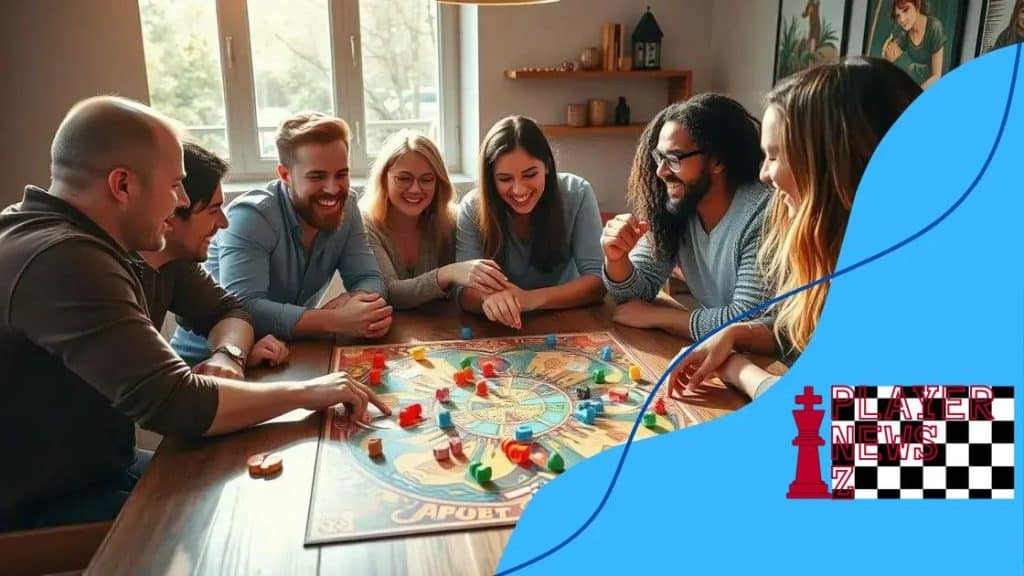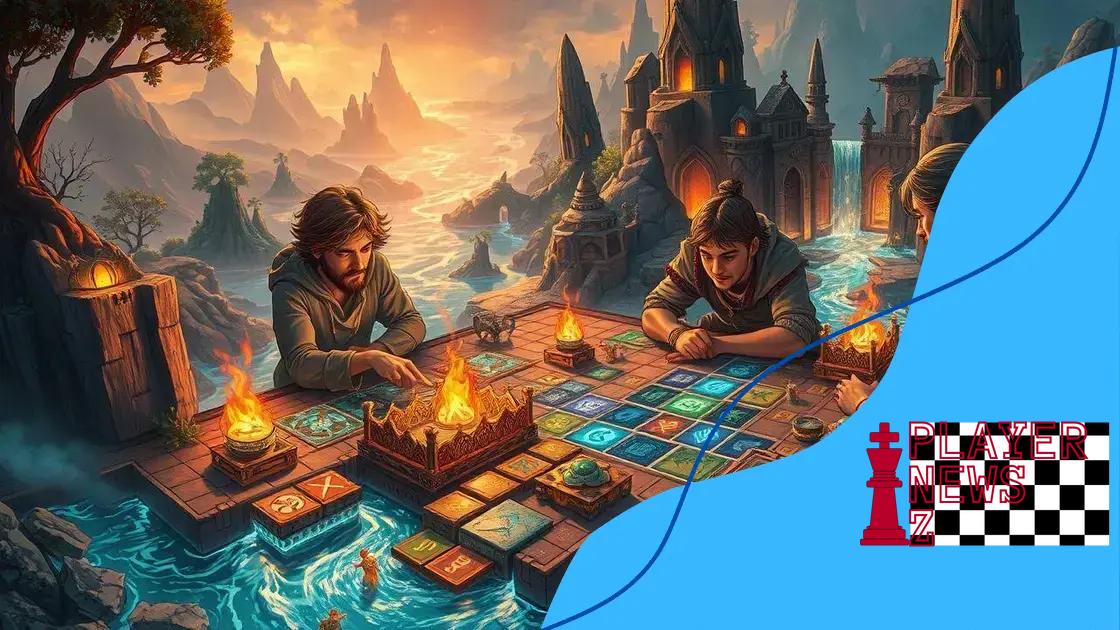The role of storytelling in modern board games

The role of storytelling in modern board games enhances player engagement by creating emotional connections, allowing player choices to affect narratives, and integrating themes that enrich overall gameplay experiences.
The role of storytelling in modern board games is crucial for captivating players and enhancing their overall experience. Have you ever found yourself lost in a game’s narrative? It’s astonishing how a good story can transform gameplay, right?
Understanding the intersection of narrative and gameplay
Understanding the intersection of narrative and gameplay is vital for creating engaging board games. A well-crafted story can enhance the gaming experience, making it more memorable and immersive. Players often connect emotionally with characters and plots, elevating the gameplay beyond mere mechanics.
How narrative affects gameplay
The relationship between narrative and gameplay is not just a backdrop; rather, it shapes the entire experience. Here are some ways storytelling influences gameplay:
- Player motivation increases as they relate to story elements.
- Decisions become more meaningful with a compelling plot.
- Emotional stakes motivate players to invest time and effort.
When players engage with a game’s narrative, they are more likely to remember their experiences and share them with others. This can lead to increased interest in the game and its expansions.
Building immersive worlds
Creating a rich game world also involves utilizing themes effectively. A well-defined environment in which the story unfolds enhances immersion. Elements to consider include:
- Visual storytelling through artwork and design.
- Consistency in theme and gameplay
- Character backstories that resonate with players.
This integration of narrative and gameplay not only attracts players but also retains their interest, as they want to explore the depths of the game’s world.
As players navigate through challenges, the decisions they make will often be influenced by the story. This creates a dynamic interplay that enriches the overall gaming experience.
How storytelling impacts player decisions
How storytelling impacts player decisions is a fascinating topic in the world of board games. Narrative elements can significantly influence how players engage with a game. When players are invested in a story, their choices become more than just tactical maneuvers; they evolve into emotional and strategic decisions.
Emotional connections
Players often develop connections with characters and scenarios presented in the game. This emotional tie affects their choices throughout the game. Below are some ways storytelling can shape decisions:
- Relating to character backgrounds fosters empathy.
- Understanding plot stakes encourages thoughtful choices.
- The narrative context makes players consider consequences.
With strong storytelling, players are likely to take risks that reflect their attachment to characters. For instance, saving a cherished character can outweigh tactical advantages.
The role of player agency
Another crucial aspect is player agency. Games that allow players to make choices that matter create a more immersive experience. When options affect the narrative outcome, players are more engaged. This connection encourages them to invest in the story they shape.
For example, a simple decision such as which path to explore can lead to diverse consequences. This unpredictability keeps players on their toes, always wondering about the outcomes of their actions.
In summary, storytelling in board games doesn’t just serve as a backdrop; it actively drives player decisions. Each choice reinforces the player’s connection to the story, making each session unique and memorable.
Creating immersive worlds in board game design

Creating immersive worlds in board game design is essential for engaging players and enhancing their experience. A well-developed game world invites players to explore, discover, and connect emotionally. When players feel they are part of a rich narrative universe, the game becomes more than just rules and pieces.
Elements of an immersive world
Several key elements contribute to building these captivating worlds. Understanding these components can make a significant difference in design:
- Art and illustrations: High-quality visuals draw players into the game environment.
- Theme consistency: A unified theme across components creates a coherent experience.
- World-building: Detailed lore and background stories add depth to the game.
These elements work together to create a believable setting that captivates players, encouraging them to invest time in the game.
Player engagement through storytelling
As players navigate through the game, each decision they make can impact the world around them. This engagement is crucial in allowing them to feel like they are part of the story.
Interactive gameplay is key. Games that allow players to shape the world through their choices not only provide a unique experience but also increase replay value. Each session can lead to different outcomes, keeping players eager to return.
Whether it’s heroic quests, intricate mysteries, or strategic battles, the narrative context not only enriches the gameplay but also enhances the emotional stakes. Players may feel a strong urge to protect their characters or explore each facet of the world presented to them.
A well-crafted world ignites imagination, making each game session a memorable adventure.
The influence of themes in player engagement
The influence of themes in player engagement is a crucial aspect of board game design. When a game’s theme resonates with players, it can significantly enhance their involvement and enjoyment. Whether it’s fantasy, horror, or historical, the theme sets the stage for the entire experience.
Thematic connection
Players are drawn into games that reflect themes they love or are curious about. A well-integrated theme allows players to immerse themselves completely. Here are some ways themes enhance engagement:
- Relatability: Themes that resonate with players’ interests create a personal connection.
- Imagination: A captivating theme sparks creativity and encourages deeper engagement.
- Motivation: Compelling narratives drive players to pursue goals and make thoughtful decisions.
When players feel that they are part of a theme, they are motivated to immerse themselves fully. This emotional investment can lead to memorable gameplay experiences.
Integrating themes within gameplay
To maximize player engagement, it’s essential to integrate themes into gameplay mechanics. This ensures that the theme is not just superficial but influences the decisions players make. For example, a survival theme can involve resource management and strategic planning, making players feel the pressure of their situation.
Additionally, thematic components, like art and storytelling, enhance the gameplay experience. Iconic visuals or powerful narratives keep players interested and eager to explore more. The match between gameplay and theme ensures a cohesive experience that captures players’ attention.
In essence, the influence of themes in board games profoundly affects how players engage with the game. A strong theme resonates, keeping players coming back for more adventures.
Examples of successful storytelling in popular games
Examples of successful storytelling in popular games showcase the power of narrative in the board gaming industry. Many games build rich stories that enhance player engagement and create unforgettable experiences. These examples illustrate how narrative can transform gameplay.
Gloomhaven
In Gloomhaven, players embark on a journey filled with adventures, branching narratives, and character development. The story unfolds as players make choices that affect their paths. Each scenario contributes to an overarching plot, creating a sense of progression and discovery.
Dungeons & Dragons
Dungeons & Dragons is a classic example of narrative-driven gameplay. Players create characters with backstories that impact their decisions. The Dungeon Master weaves the players’ stories into a rich world, allowing for personalized adventures.
Ticket to Ride
Ticket to Ride incorporates a simple yet engaging theme of train travel across various countries. The objective ties closely to the narrative of connecting cities, and the player experience is enhanced by the scenic imagery and strategic planning involved.
Arkham Horror
In Arkham Horror, players immerse themselves in Lovecraftian themes and narratives filled with mystery and horror. The game’s storyline evolves depending on players’ actions, fostering a sense of urgency and foreboding that keeps them on edge.
These examples highlight that storytelling in board games is not just an afterthought; it is integral to the overall enjoyment and experience. By crafting compelling narratives, these games encourage players to engage deeply with their worlds and each other.
FAQ – Frequently Asked Questions about Storytelling in Modern Board Games
How does storytelling enhance board games?
Storytelling enhances board games by creating emotional connections, making gameplay more engaging and memorable for players.
What are some examples of games with strong narratives?
Some popular games with strong narratives include Gloomhaven, Dungeons & Dragons, and Arkham Horror, each offering rich stories that impact gameplay.
Why are themes important in player engagement?
Themes provide a context for the game, helping players connect emotionally and stay engaged, thereby enhancing their overall experience.
Can player choices affect the game’s story?
Yes, many modern board games allow player choices to influence the story, which makes each session unique and personalized.





